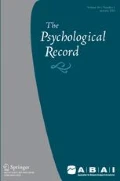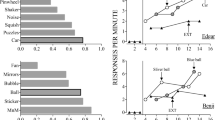Abstract
The present study examined two procedures for teaching simple discrimination to six toddlers aged 10- to 20-months. A pair of toys was displayed in the windows of an automated apparatus in each training session. Touching the S+ toy window allowed access to the toy and playing with it. Touching the S− toy window produced closure of both windows and the end of the trial. The two procedures varied in exposing the participants to differential reinforcement. In Procedure A, the first choice was always incorrect. In Procedure B, the first four trials were alternating forced choices of the S+ and S−. The participants were trained in 10 to 12 discrimination problems. Four toddlers learned four to six problems with both the procedures. The procedures reported in the present study may be applicable to teaching effectively discriminative repertoires to toddlers, older children, and adults with low verbal repertoires.

Similar content being viewed by others
Notes
Following Feller (1968), the probability of not obtaining c consecutive heads (or equally, tails) when tossing a coin n times [let us call this probability P(n; c)] can be approximated by
$$ P\left(n,c\right)=\frac{ Bc}{A{c}^{n+1}}, $$where Bc and Ac are called Feller’s coin tossing constants and are defined in the following way: Ac is the smallest positive real root of the polynomial
$$ {x}^{c+1}-{2}^{c+1}x+{2}^{c+2}=0 $$and
$$ Bc=\frac{2- Ac}{c+1-c\times Ac}. $$Therefore, the probability of obtaining c consecutive heads in n independent tosses of a fair coin is approximately
$$ 1-P\left(n,c\right). $$
References
Catania, A. C. (1998). Learning (4th ed.). Upper Saddle River: Prentice-Hall.
Cumming, W. W., & Berryman, R. (1965). The complex discriminated operant: Studies of matching-to-sample and related problems. In D. I. Mostofsky (Ed.), Stimulus generalization (pp. 284–330). Stanford: Stanford University Press.
Dube, W. V., & Serna, R. W. (1998). Re-evaluation of a programmed method to teach generalized identity matching to sample. Research in Developmental Disabilities, 19, 347–379.
Feller, W. (1968). An introduction to probability theory and its applications (3rd ed., Vol. 2). New York: John Wiley and Sons.
Frankenburg, K. W., Dodds, J., Archer, P., & Bresnick, B. (1990). Denver II: Technical manual. Denver: Denver Developmental Materials.
Gil, M. S. C. A., Oliveira, T. P., Sousa, N. M., & Faleiros, D. A. M. (2006). Variáveis no ensino de discriminação para bebês. Psicologia: Teoria e Pesquisa, 22, 143–152. Retrieved from http://www.scielo.br/scielo.php?script=sci_serial&pid=0102-3772.
Gil, M. S. C. A., Oliveira, T. P., & McIlvane, W. J. (2011a). Conditional discriminations by preverbal children in an identity matching-to-sample task. The Psychological Record, 61, 327–340.
Gil, M. S. C. A., Sousa, N. M., & de Souza, D. G. (2011b). Dois procedimentos para introduzir reforçamento diferencial no ensino de discriminações simples a bebês. Acta Comportamentalia, 19, 163–182. Retrieved from http://www.revistas.unam.mx/index.php/acom.
Kagan, J. (1981). The second year: The emergence of self-awareness. Cambridge: Harvard University Press.
Lionello DeNolf, K. M., Barros, R. S., & McIlvane, W. J. (2008). A novel method for teaching the first instances of simple discrimination to nonverbal children with autism in a laboratory environment. The Psychological Record, 58, 229–244. Retrieved from http://opensiuc.lib.siu.edu/tpr.
Lipkens, R., Hayes, S. C., & Hayes, L. J. (1993). Longitudinal study of the development of derived relations in an infant. Journal of Experimental Child Psychology, 56, 201–239. Retrieved from http://dx.doi.org/10.1006/jecp.1993.1032.
Luciano, C., Gomez-Becerra, I., & Rodriguez-Valverde, M. (2007). The role of multiple-exemplar training and naming in establishing derived equivalence in an infant. Journal of the Experimental Analysis of Behavior, 87, 349–365. doi:10.1901/jeab.2007.08-06.
McIlvane, W. J., & Stoddard, L. T. (1981). Acquisition of matching-to-sample performances in severe mental retardation: learning by exclusion. Journal of Mental Deficiency Research, 25, 33–48.
Oliveira, T. P., & Gil, M. S. C. A. (2008). Condições experimentais facilitadoras para a aprendizagem de discriminação por bebês. Psicologia: Teoria e Pesquisa, 24, 05–18. Retrieved from http://www.scielo.br/scielo.php?script=sci_serial&pid=0102-3772.
Pedromônico, M. R. M., Bragatto, E. L., & Strobilus, R. (1999). Teste de Triagem Denver II. São Paulo: UNIFESP.
Pilgrim, C., Jackson, J., & Galizio, M. (2000). Acquisition of arbitrary conditional discriminations by young normally developing children. Journal of the Experimental Analysis of Behavior, 73, 177–193. doi:10.1901/jeab.2000.73-177.
Schreibman, L. (1975). Effects of within-stimulus and extra-stimulus prompting on discrimination learning in autistic children. Journal of Applied Behavior Analysis, 8, 91–112. doi:10.1901/jaba.1975.8-91.
Serna, R. W., Dube, W. V., & McIlvane, W. J. (1997). Assessing same/different judgments in individuals with severe intellectual disabilities: a status report. Research in Developmental Disabilities, 18, 343–368. Retrieved from http://dx.doi.org/10.1016/S0891-4222(97)00015-2.
Sidman, M., & Stoddard, L. T. (1967). The effectiveness of fading in programming a simultaneous form discrimination for retarded children. Journal of the Experimental Analysis of Behavior, 10, 3–15. doi:10.1901/jeab.1967.10-3.
Silva, F. T. N., & Souza, C. B. A. (2009). Discriminação simples com mudanças sucessivas na função dos estímulos: aprendizagem em bebês. Psicologia: Teoria e Pesquisa, 25, 569–580. Retrieved from http://www.scielo.br/scielo.php?script=sci_serial&pid=0102-3772.
Terrace, H. S. (1963). Discrimination learning with and without “errors”. Journal of the Experimental Analysis of Behavior, 6, 1–27. doi:10.1901/jeab.1963.6-1.
Weisberg, P. (1969). Operant procedures for the establishment of stimulus control in two-year-old infants. Journal of Experimental Child Psychology, 7, 81–95. doi:10.1016/0022-0965(69)90087-3.
Weisberg, P., & Rovee-Collier, C. (1998). Behavioral processes of children and young children. In K. A. Lattal & M. Perone (Eds.), Handbook of research methods in human operant behavior (pp. 325–370). New York: Plenum Press.
Wilkinson, K. M., & McIlvane, W. J. (2001). Methods for studying symbolic behavior and category formation: contributions of stimulus equivalence research. Developmental Review, 21, 355–374. doi:10.1006/drev.2000.0526.
Acknowledgments
This research was supported by a doctoral grant from FAPESP (no. 10/15602-8) to the first author. All of the authors are currently affiliated with the Instituto Nacional de Ciência e Tecnologia sobre Comportamento, Cognição e Ensino, supported by FAPESP (grant no. 08/57705-8) and CNPq (grant no. 573972/2008-7), which provided support for the preparation of this manuscript. The authors thank Thaise Löhr for her help with data collection, Raúl Oset Sinha for his mathematical assistance, and Olavo Galvão and other anonymous reviewers for their criticisms that improved the manuscript.
Author information
Authors and Affiliations
Corresponding author
Rights and permissions
About this article
Cite this article
Minto de Sousa, N., Garcia, L.T. & Gil, M.S.C.d.A. Differential Reinforcement in Simple Discrimination Learning in 10- to 20-Month-Old Toddlers. Psychol Rec 65, 31–40 (2015). https://doi.org/10.1007/s40732-014-0081-4
Published:
Issue Date:
DOI: https://doi.org/10.1007/s40732-014-0081-4




